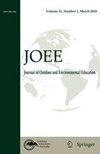COVID大流行期间中国幼儿教育和护理中心儿童的户外活动
IF 1.4
Q3 EDUCATION & EDUCATIONAL RESEARCH
引用次数: 0
摘要
近年来,中国的幼儿教育和户外教育发展迅速。重要的是,它是第一个发现COVID-19病例并实施封锁和其他限制措施的国家。中国幼儿教育工作者没有机会向其他国家的同龄人学习如何应对COVID-19限制。目前尚不清楚这些限制是如何影响儿童进入户外活动的。目前的研究调查了儿童的户外时间、进入户外空间的机会以及对儿童户外游戏的限制是否发生了变化。然后,我们检查了改变或保持不变是否受到教育者资格、户外教育学相关的专业发展、教育者对游戏风险的容忍度以及教师与儿童的比例的影响。大多数教育工作者报告说,与大流行前相比,儿童在户外度过的时间和进入户外空间的机会保持不变。更多的教育工作者表示,由于大流行,儿童的户外活动受到限制。一系列有序回归分析表明,在大流行期间,对游戏风险容忍度较高的教育工作者更有可能增加儿童在户外度过的时间和进入户外空间的机会,并减少对儿童户外游戏的限制。工作人员与儿童的比例越高,户外时间和户外空间就越多。这些发现有助于理解外部因素如何影响儿童户外玩耍的机会,并为未来的专业发展计划和风险重建干预提供方向。本文章由计算机程序翻译,如有差异,请以英文原文为准。
Children’s access to outdoors in early childhood education and care centres in China during the COVID pandemic
Abstract China has undergone rapid development in early childhood education and outdoor pedagogy in recent times. Importantly, it was the first country to detect COVID-19 cases and introduce lockdowns and other restrictions. Chinese early childhood educators had no opportunities to learn from their peers in other countries regarding how to respond to COVID-19 restrictions. It is unknown how these restrictions may have impacted children’s access to the outdoors. The current study examined whether there had been changes in children’s outdoor time, access to the outdoor space, and restrictions imposed on children’s outdoor play. We then examined if making changes or remaining the same was influenced by educator qualifications, professional development related to outdoor pedagogy, educators’ tolerance of risk in play, and staff-child ratios. Most educators reported that the amount of time children spent outdoors and their access to the outdoor space remained the same compared to before the pandemic. A greater number of educators indicated restrictions were imposed on children’s outdoor play due to the pandemic. A series of ordinal regression analyses indicated that educators with a higher tolerance of risk in play were more likely to increase children’s time spent outdoors and access to outdoor space and impose fewer restrictions on children’s outdoor play during the pandemic. A higher staff-child ratio was associated with increasing outdoor time and outdoor space. The findings contribute to the understanding of how external factors influence opportunities for children to play outdoors and provide directions for future professional development programs and risk-reframing interventions.
求助全文
通过发布文献求助,成功后即可免费获取论文全文。
去求助
来源期刊

Journal of Outdoor and Environmental Education
Social Sciences-Education
CiteScore
2.60
自引率
35.00%
发文量
28
期刊介绍:
The Journal of Outdoor and Environmental Education (JOEE) is a double-blind peer-reviewed journal devoted to the scholarly examination of issues in outdoor and environmental education. JOEE provides a forum in which outdoor and environmental education professionals from all settings can exchange and discuss ideas and practices relevant to their work.JOEE invites submissions of papers of between 4000 and 8000 words (including reference list and abstract) that focus on enhancing understanding of outdoor and environmental education issues through balanced and in-depth investigation of practices and theories relevant to outdoor and environmental education. Shorter book/document reviews are also welcomed.JOEE does not privilege any particular methodology or theory and welcomes contributions from various standpoints. However, editorial will prioritise papers that take into consideration a broad readership which includes teachers and other practitioners as well as researchers, requiring authors to express and explain evidence and theory using language that is accessible to readers beyond a particular community. With this in mind, we ask authors, on acceptance of their paper, to produce a short video which will be made accessible in order to share the main messages contained in their paper with a wide audience.
 求助内容:
求助内容: 应助结果提醒方式:
应助结果提醒方式:


